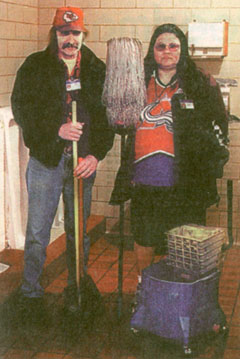
Glenn Baglo, Vancouver Sun
WASHROOM CARETAKERS: Jim and Julie Scott look after the public toilets at Hastings Street. |
P. A1.
The Toughest Job in Town
It was six years back — with the hookers, pimps and dealers in full control of their tiled turf — that Jim Scott and wife Julie embarked on careers filled with danger, excitement and sewage.
Their City of Vancouver photo ID badges say it all: "Main and Hastings Comfort Station Attendant."
A comfort station is a sanitized term for public toilets, but not just any public toilets. Julie and Jim work the toughest toilets in town.
They are part of a proud city heritage stretching back some 75 years. Their world is the flush and gurgle of Vancouver's two surviving underground public washrooms — those under Victory Square and those under Main and Hastings.
They hold the city contract for both aging facilities, operated at an annual cost of $170,000. But it is the dank bunker at Main and Hastings that consumes them — the hardest, most drug-infested corner of the poorest neighbourhood in Canada.
By all accounts — save a few disgruntled crackheads — they run a darn fine bathroom. They are not a hard or cynical team, nor are their eight full- and part-time employees.
They arrived with the Javex and mops to toilet-train the Downtown Eastside, but it was tougher than even they imagined. Frontier law ruled: existing staff cowered in locked attendants' rooms, content to let hookers, dealers and addicts run the place.
Over time, they've been abused, attacked and, in Julie's case, threatened by a gun-wielding pimp.
In a moment of despair, Julie made a promise: she would make these toilets safe enough for a child to visit.
Their victories are rewon daily with a combination of cunning, tough love, and elbow grease.
Some things are better today, some are worse. "It's the rock cocaine, more than anything," says Jim. For Julie, it's the gangs, each fighting for a place on the corner.
"There's going to be a gang war some day," she warns, as the sounds of an argument, sharp as broken glass, crash down the stairs.
"Not here, though," she says. "We're Switzerland. We're neutral."
Over time, the Scotts have brought Julie's son, 22-year-old Floyd Jewell, into the family business.
Jewell was in high school when he started pulling the occasional shift, under the protective tutelage of Jim, his step-father. Now he works a four-day week, half of it in the comparative calm of Victory Square.
Two days a week is all his parents will schedule him in the maelstrom of Main and Hastings. Initially, it was a blow to the young man's pride. He has since appreciated their compassion.
Main and Hastings grows worse. "It was bad, but it wasn't, like, bad-bad," Jewell explains. "There's a difference."
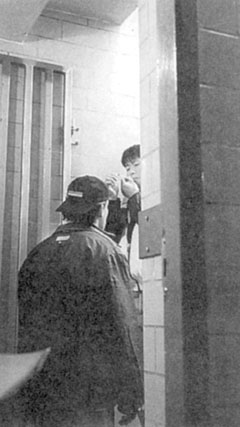
Glenn Baglo, Vancouver Sun
DIVERSE CLIENTELE: Drug dealers often use the stairwell to make their exchanges out of open view of the police. |
Toilet Theory
Margaret Andrews, a professor in the history department of Washington State University, has a theory about Vancouver's public washrooms: Their installation, around the turn of the 20th century, marked a "retreat of the frontier."
She made her case in a delicately-worded academic essay published a decade ago in the BC Studies journal.
It was a guy thing, in her view. As late as 1891, Vancouver's 65 per cent male population "gave it a frontier flavour, to which an abundance of saloons and brothels contributed, along with the comparatively unrefined toilet behaviour, which concerns us here."
This she defines as an "unfettered response to calls of nature."
Awash in waste by 1896, Vancouver began the civilizing process of installing public toilets. Fragrant terms like "water closet" and "public convenience" filled city records.
Most facilities, though, were urinals for men. That women might require "comfort" was initially beyond the grasp of city fathers.
By the 1920s, women won a place in a series of underground toilets installed at busy downtown thoroughfares, including south of the Granville Street bridge, Kingsway and Broadway, and the two surviving facilities on Hastings.
Prophetically, city planners of the day included attendants' rooms in the downtown (eastside) locations — apparently to keep the peace. There, not unlike today, "remnants of frontier culture were … particularly persistent," Andrews writes.
The academic study of toilets has a perverse appeal to Jim Scott.
He is sitting in the attendant's office. His chair is chained to a sewer pipe so it can't be stolen. He's just banished from the toilets two guys with crack pipes. A guy on the stairs is jamming heroin into his arm.
Toilets as a civilizing influence? He hoots across the room to his wife: "Boy, have they come full circle now."
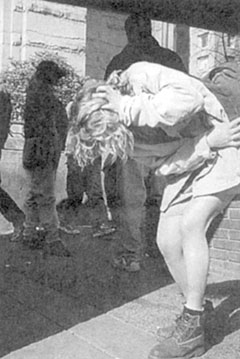
Glenn Baglo, Vancouver Sun
DIVERSE CLIENTELE: Addicts frequent the sidewalk above the public toilets at Main and Hastings. |
Stalled lives
At 6:30 a.m. this is the view from Main and Hastings:
Across Burrard Inlet, the sunrise has hit the North Shore mountains, shattering the red spectrum into a thousand hues that stain the sky and colour the mountain snow.
Down on the corner, Jim and Julie cast their eyes briefly to the hills, before returning their attention to the litter, glass and needle wrappers on the sidewalk.
A young man in his 20s, anxious for the toilet's steel gates to open, bleeds all over the stairwell.
Julie and Jim are largely ignored as they clean up a night's anarchy. They sweep around drug deals and twitching needle junkies and scrawny hookers in bum-freezer mini-skirts.
A visitor, however, merits attention. Within minutes come offers of every conceivable drug and sexual service, as well as a veritable wardrobe of hot clothing. Commerce never sleeps.
A sunny day such as this is a joy to Julie and Jim, though they will see it only when they surface for cigarette breaks. Fewer people will crowd the stairwell and the stalls to keep dry or to shoot up.
Yet even on nice days, the game of cat-and-mouse continues.
Jim and Julie employ different strategies across the gender divide.
The men's side handles 1,000 visitors a day, some of whom actually want to use the toilet. For the rest, Jim has little sympathy and an arsenal of tricks.
For instance, it is freezing down here. In the winter he keeps it cold, in the summer, he cranks up the heat. It is a way of ensuring no one lingers.
In the washroom's north corner, Jim has installed a blower. The wind-tunnel effect sends powdered drugs flying and makes the lighting of crack pipes a difficult proposition.
Two weeks ago, he installed black lights, bathing the washroom in a dim purple twilight. "They can't shoot up," he says, "if they can't see their veins."
Lord knows, though, they try. "Gotta flashlight?" asks one, poking his head in Jim's office.
Jim has a grudging respect for the persistence of the average drug addict. "If they were to put their effort to good use," he says, "they'd find a cure for cancer."
By contrast, Julie's turf, the women's side, is bright and inviting. The tiles are a friendly yellow. There are doors on the toilet stalls. There are lights.
Julie tracks the activity from a convex mirror visible from the attendant's office, as she works through a book of crossword puzzles. Her walls are covered with cheerful photos of her children and grandchildren.
What Julie has are RULES. They are posted on plywood over the sinks.
RULES for things that make your stomach flip just thinking about them.
A partial list:
- No drugs, or alcohol or smoking it.
- No washing hands in water fountain.
- No loitering at any time or warming up or sleeping.
- Subject to check on drug users, as in looking over stall, watching under stall. When caught, could be barred depending on the circumstance.
- No picking ones self anywhere in this washroom. It's a health hazard. (Junkies, Julie explains with a grimace, are forever tearing at their skin, picking scabs, drawing blood.)
- If you shoot up, expect a bucket of water dumped over the stall without warning.
Don't think she hasn't done it.
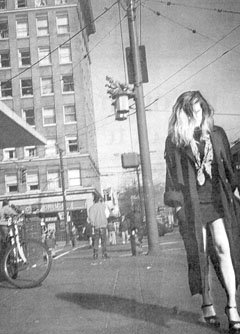
Glenn Baglo, Vancouver Sun
DIVERSE CLIENTELE: Desperate addicts search cracks in sidewalk above the toilets, looking for fragments of crack cocaine. |
Not the living room
Above ground, sharing the southwest corner of Main and Hastings, is the Carnegie Centre, with its plethora of community programs for body, mind and spirit.
On a recent morning, Carnegie director Michael Claygue waved a cheery hello to Julie and Jim, wheeled his bike safely inside the 97-year-old centre and reflected on the scene outside.
"It's hard not to describe it in emotional terms at both ends," he says of the corner. "Because it simply exposes there life's tragedies and some incredible courage as well."
The corner, both Claygue and Jim Scott agree, defies an easy solution.
Where they differ, is how to achieve this. Claygue sees the Carnegie as "the living room of the Downtown Eastside", whereas Scott has no illusions about the service he provides.
Both rooms are necessary, but Scott questions the wisdom of making this corner so welcoming.
Here, at the heart of the drug trade, are needle exchanges and street nurses, and clothing and counselling, and soup kitchens and all manner of well-meaning, well-funded programs.
"So," says Scott, "they'll be in jail and off drugs and the first place they go is back here. It's like a magnet or something." He points to a woman scouting for drugs, half of a husband and wife team who'd been in rehab and off the street for months.
"What they're doing isn't working. It's certainly putting a lot of money in people's pockets, but it isn't working."
Upstairs in the Carnegie, Claygue respectfully disagrees. There is no value is sweeping people off the corner and into back alleys.
"We're committed to having the activity, the open drug scene, closed, but we know that it needs to take place coincident with real alternatives."
Downstairs, Scott considers this a bit naive. Maybe it's his frustration with a society that can't decide if drugs are a criminal or a social ill.
"Nobody will help these people," he says. "This corner, it's like their safety net. I get frustrated with the people, and I get frustrated with a system that isn't helping them."
Such worries, of course, aren't in the job description, but they come with the turf.
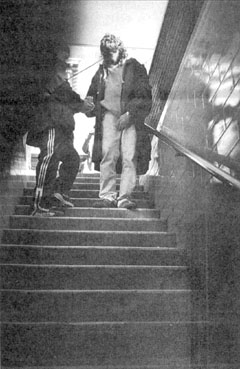
Glenn Baglo, Vancouver Sun
DIVERSE CLIENTELE: Users will duck into the stairwell to smoke crack out of the wind. |
Done for love
Long story short: Julie met Jim at the York Hotel in Grande Prairie, Alta. — same place she met her three previous husbands.
She used to work there, but the York was a better place to fall in love than to stay in love. Until she met Jim, she concedes, "I sort of didn't pick them very well."
One day all three of her ex-husbands were at the hotel. Jim, a veteran bar manager in garden spots like Red Earth, Alta., happened to be passing through town. "I'm sitting there, listening to this, and I thought: I gotta talk to this gal."
The love match has survived many things, not the least of which is six years, sub-surface.
They try not to take their work home, as you might imagine. But, from break-ins to plumbing emergencies, the job is all-consuming. "There are times," says Julie, "when the washroom comes to us."
For this, their staff are paid somewhat better than minimum wage, and all the bathroom breaks they need. The Scotts don't get a whole lot more, but there are other "rewards," says Jim.
There's John and Kevin, two pals they nagged into rehab and off the streets.
There's the good people of the eastside like Haluk, a personable Inuk who moved south for the climate, and who popped in to show off Dancing Bear, his latest alabaster carving.
There's son Floyd, their pride and joy. They didn't need sermons to keep him away from drugs, just a couple of shifts underground. Floyd says he'll stick with the job as long as his parents need him.
It comes clear in separate interviews that they think they're helping Floyd, and Floyd thinks he's helping them. The funny thing is, they're both right.
What they share is a transcending dignity that comes in a job — any job — well done.
It's mid-afternoon and Julie — oblivious to the bone-creeping chill — watches an elderly Chinese woman leave facilities as safe and clean and welcoming as she can make them.
She smiles and recalls her early wish to see a child down here.
It took six months of Javex and abuse, but one day it happened. A mother came down the stairs, clutching her daughter's hand. And Julie Scott started to cry.
Public (Washroom) Behaviour of the Old-Fashioned Sort
- "City council minutes show that toilet attendants were expected to keep the facilities clean, and they could further cater to the fastidious by providing soap and towels through hatches facing the wash-basins."
- "On the other hand, the extensive use of glass in the walls of the attendants' rooms suggests that they were also intended to discourage crude or disorderly behaviour."
- "Before the turn of the century, frontier attitudes and practices were not unusual. People were not particularly fastidious, unpleasant smells were an accepted part of the urban environment, and toilet habits were casual. …"
From Sanitary Conveniences and the Retreat of the Frontier: Vancouver, 1886-1926, by Margaret Andrews
|


![[Vancouver 2000]](van2000crm.gif)
![[News by region]](../regioncrm.gif)
![[News by topic]](../topiccrm.gif)
